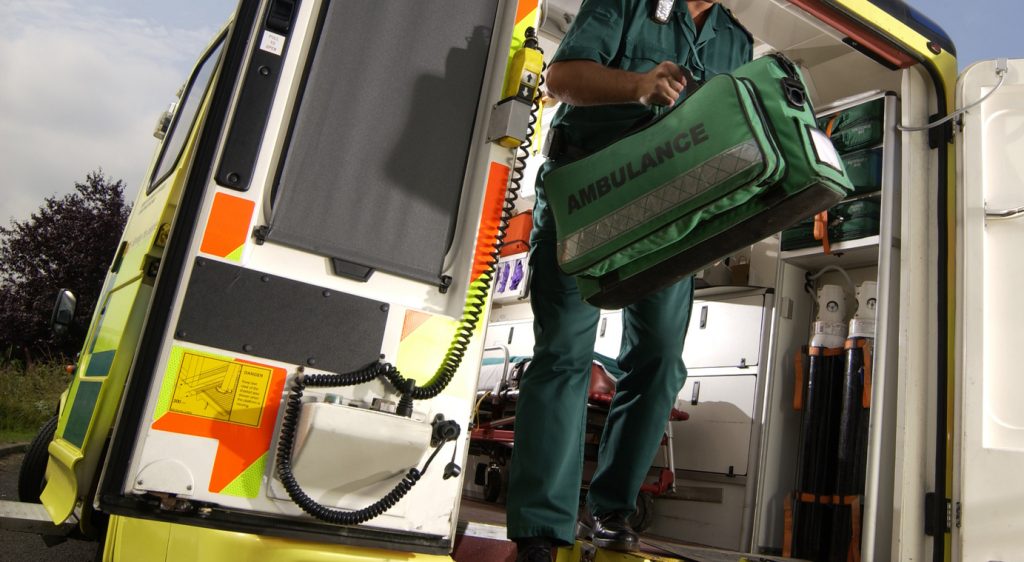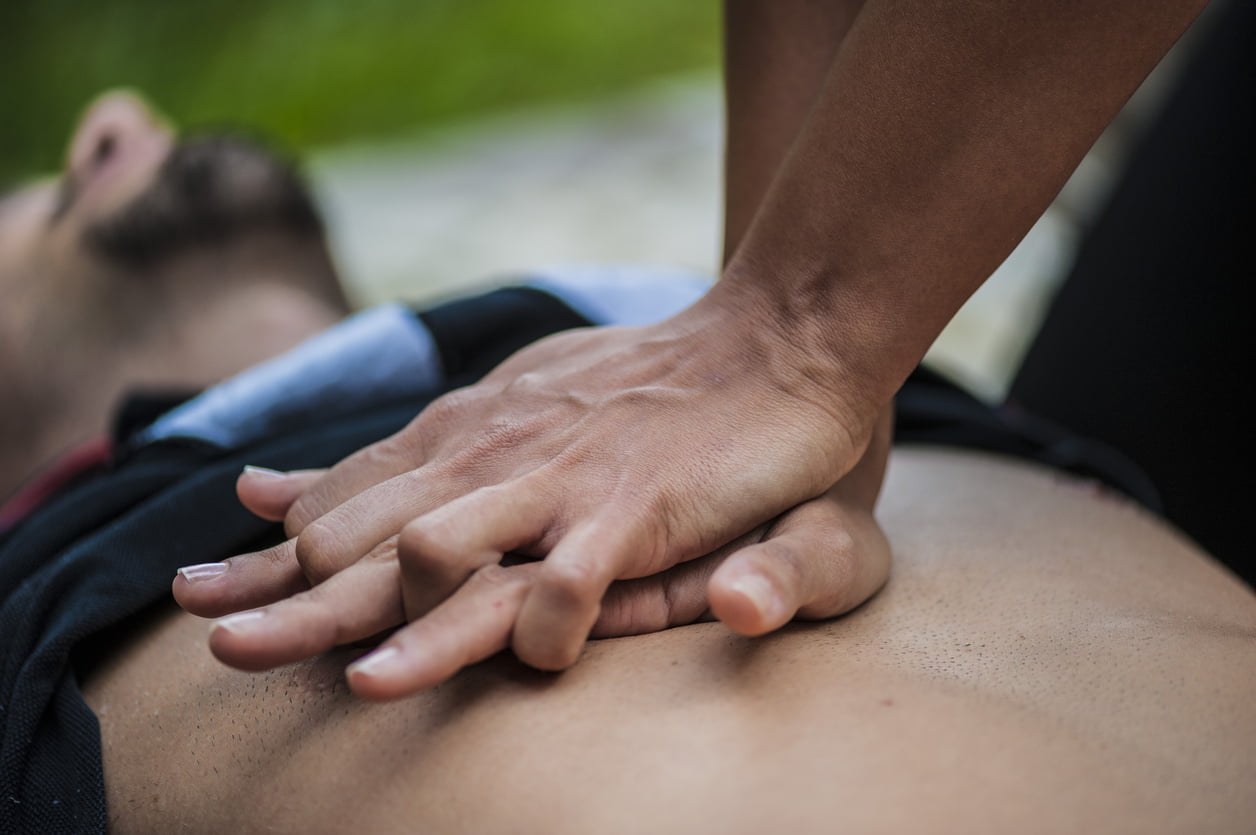In this blog for paramedics and other prehospital emergency medical providers, paramedic Scott Munro looks at new Cochrane evidenceCochrane Reviews are systematic reviews. In systematic reviews we search for and summarize studies that answer a specific research question (e.g. is paracetamol effective and safe for treating back pain?). The studies are identified, assessed, and summarized by using a systematic and predefined approach. They inform recommendations for healthcare and research. on approaches to cardiopulmonary resuscitation for out-of-hospital cardiac arrest.
Page last checked 10 March 2023
It’s half-way through a busy night shift when you get a call come in for a 64-year-old male that’s collapsed at home. En route, an update comes through. He’s not breathing. When you arrive, you scramble through the front door with your crew mate and kit and you see the patient lying on the floor of the cramped bedroom with a family member doing cardiopulmonary resuscitation (CPR). There’s a mobile phone on the floor on loud speaker and you can hear the call taker on the other end of the line, calmly giving advice to the family member, as they do their best to save their loved one. The family member is being instructed to give continuous chest compressions, to put their hands in the middle of their chest and press hard and fast. But no ventilations. As you and your crew mate take over care of the patient, is it best that you carry on continuous chest compressions or should you be doing compressions and ventilations?
Surviving cardiac arrest out of hospital
If you have a cardiac arrest outside of hospital, your chances of surviving aren’t fantastic. In the UK cardiopulmonary resuscitation (CPR) is attempted by the emergency medical services on 30,000 people every year, with survival rates as little as 7-8%. The chain of survival is an illustration that emphasises the important links involved in giving people the best chances of having a good outcome.
Early recognition and call for help; early CPR; early defibrillation; and post-resuscitation care.
Notice the emphasis on early?
If someone provides CPR very shortly after a patient goes into cardiac arrest, their chances of survival treble. However, at the moment only 30-40% of out-of-hospital cardiac arrests receive any bystander CPR before the ambulance service arrives.

Compressions and ventilation?
There are many questions and uncertainties surrounding the current care provided during out-of-hospital cardiac arrest. The International Liaison Committee on Resuscitation (ILCOR) published an international Consensus on Science and TreatmentSomething done with the aim of improving health or relieving suffering. For example, medicines, surgery, psychological and physical therapies, diet and exercise changes. Recommendations in 2015, which is used by the Resuscitation Council UK to inform their guidelines on out of hospital resuscitation. Only 1% of these recommendations are based on high-level evidence.
One question raised around resuscitation is whether chest compressions should be provided with pauses for rescue breaths, or whether they should be provided continuously, without interruptions.
Chest compressions are provided to try and pump blood round circulatory system and keep up a blood supply to cardiac muscle and brain, while ventilations attempt to oxygenate the blood. Pauses in chest compressions have been shown to have associations with worse survival due to a reduction of coronary perfusion pressure.
Current guidelines in the UK from the Resuscitation Council advise that bystanders are given advice over the phone from a 999 call taker to provide continuous chest compressions, unless trained and competent in combining CPR with mouth-to-mouth, while emergency medical services (EMS) are advised to provide compressions and ventilations in a ratio of 30:2. If the patient is intubated or has a supraglottic device put in place, ventilations can then be provided at a rateThe speed or frequency of occurrence of an event, usually expressed with respect to time. For instance, a mortality rate might be the number of deaths per year, per 100,000 people. of 10 per minute, without the need for a pause in chest compressions (given asynchronously).
What does the evidence say?
In March 2017, Zhane et al recently published a Cochrane ReviewCochrane Reviews are systematic reviews. In systematic reviews we search for and summarize studies that answer a specific research question (e.g. is paracetamol effective and safe for treating back pain?). The studies are identified, assessed, and summarized by using a systematic and predefined approach. They inform recommendations for healthcare and research. on Continuous chest compression versus interrupted chest compression for cardiopulmonary resuscitation of non‐asphyxial out‐of‐hospital cardiac arrest. The review was really asking the same question for two different groups. What should untrained bystanders do? And what should EMS professionals do?
Asking these questions seems appropriate, because CPR provided by these two groups will in all likelihood be different. The bystander group will be providing CPR with advice over the telephone and little or no previous experience, while the EMS group will have received professional training and equipment and have more experience in providing CPR.
Three randomisedRandomization is the process of randomly dividing into groups the people taking part in a trial. One group (the intervention group) will be given the intervention being tested (for example a drug, surgery, or exercise) and compared with a group which does not receive the intervention (the control group). controlled trialsA trial in which a group (the ‘intervention group’) is given a intervention being tested (for example a drug, surgery, or exercise) is compared with a group which does not receive the intervention (the ‘control group’). and one cross-over cluster randomised controlled trialA trial in which the people taking part are randomly divided into groups. A group (the intervention group) is given the intervention being tested (for example a drug, surgery, or exercise) and compared with a group which does not receive the intervention (the control group). were found by the review authors, with a large sample of 26,742 participants included in the analysis.
The primary outcomesOutcomes are measures of health (for example quality of life, pain, blood sugar levels) that can be used to assess the effectiveness and safety of a treatment or other intervention (for example a drug, surgery, or exercise). In research, the outcomes considered most important are ‘primary outcomes’ and those considered less important are ‘secondary outcomes’. the authors were interested in were survival to hospital discharge and survival to hospital admission. Neurological outcomes were studied, but only as secondary outcomes.
The review only included patients that died of a presumed cardiac causes. Patients that died from drug overdoses, trauma, alcohol intoxication or asphyxia (choking, drowning, lack of oxygen) were excluded.
What did they find?
The results showed that untrained bystander CPR had better outcomes when given telephone advice from EMS services to perform continuous CPR, rather than interrupted CPR with rescue breaths. In fact, an additional 25 per 1000 would survive to hospital discharge if given continuous chest compressions by bystanders. This is high quality evidence, so we can be confident that further research is very unlikely to change the estimate of effect.
For trained EMS professionals, results showed that there was probably no benefit in survival to hospital discharge when performing continuous CPR versus CPR interrupted with rescue breaths. This evidence is moderate quality and it is possible that there is little or no difference between the two approaches. There were slightly lower rates of survival to admission or discharge following continuous chest compression, but little or no difference in neurological outcome or adverse effects.
So why the difference between the two groups? The authors suggest that the difference may be due to the quality of chest compressions delivered by bystanders, compared with EMS personnel.
There are questions still to be answered. The review authors highlight the need for research into adverse effects, longer term neurological outcomes and quality of life, as well as the influence of automated external defibrillator availability and use, and whether continuous chest compression CPR is appropriate for paediatric cardiac arrest.
You can connect with Scott @ScottFSMunro on Twitter, where he runs a prehospital journal club #PHJC
Scott Munro has nothing to disclose. Views are Scott’s own.
References may be found here.



I cannot understand what benefit to the patient could possibly occur upon cessation of CPR. The suffering of bystanders? Time for lunch? It seems to me that every possible action should be continued until a qualified physician makes the determination that there is nothing left for the patient to gain prior to any consideration of ceasing assistance. If it is the difficult question of choosing how best to allocate immediate resources then that is another matter entirely. While the probability of survival of the patient decreases as the length of time in arrest increases, that is what it is, a probability. For a person dedicated to the rescue or survival until more efficacious means of treatment are reached, I cannot see one declaring “I’ve done my part. Let them die.”, without facing discharge and possible legal action on the part of families and other caring souls, seeking to be sure no one else would be abandoned by such a callused mentality.
Hi Tim, thanks for your comment. I’m not sure where you work from, but in the UK we have some guidance on when to stop and start resuscitation. The Association of Ambulance Services Chief Executives (through the Joint Royal Colleges Ambulance Liaison Committee, Ambulance Service UK Clinical Practice Guidelines), and the joint statement from the British Medical Association, the Resuscitation Council (UK) and the Royal College of Nursing both provide guidance on decisions concerning starting and stopping CPR.
Here’s some of the guidance from the Resuscitation Council UK, I’d be interested to know your thoughts:
In the presence of cardiorespiratory arrest, and in the absence of a documented do-not-attempt cardiopulmonary resuscitation (DNACPR) decision or advance decision to refuse treatment (ADRT), ambulance clinicians should start CPR unless the patient has a condition unequivocally associated with death.
Decapitation
Massive cranial and cerebral disruption
Hemicorporectomy (or similar massive injury)
Incineration (>95% full thickness burns)
Decomposition/putrefaction
Rigor mortis and hypostasis.
If a person is known to be in the final stages of an advanced and irreversible condition, in which attempted CPR would be both inappropriate and unsuccessful, CPR should not be started. Even in the absence of a recorded DNACPR decision, experienced clinicians may be able to recognise this situation and make an appropriate decision, based on clear evidence that they should document. Where there is doubt, it may be necessary to start attempted CPR and to review whether or not to continue in the light of any further information received during the resuscitation attempt.
All decisions to attempt CPR, withhold CPR or stop CPR must be based on the best interests of the patient. These should be guided by what the patient would have chosen for themselves if they had had the capacity to decide. If the patient has appointed a legal representative (e.g. Power of Attorney) to make such decisions on their behalf that person must be consulted (if they are present or contactable immediately at the time of the arrest). Otherwise, whenever possible, decisions should take into account the views of the patient’s family or others close to the patient. Their role is to guide clinicians as to the patient’s previously expressed beliefs and wishes, and their own views, but it is crucial that they understand that they are not being asked to decide whether to start, to withhold or to stop CPR. That decision must be made by the senior clinician. In any cardiac arrest the best interest of the patient remain paramount. Consultation with others or attempts to contact others must not be allowed to compromise the chances of recovery by delaying CPR that is or may be appropriate.
https://www.resus.org.uk/resuscitation-guidelines/prehospital-resuscitation/
An inherent problem with cardiac arrest statistics is the ability of the clinician to identify a futile resuscitation attempt. As paramedics seem to be getting younger and less experienced, they appear to me (anecdotal evidence i know) to be performing more resuscitation attempts on patients that should be left alone. Unfortunately training nowadays tends to portray a massive, no holds barred resus as the holy grail of paramedic practice and there’s little training on when to start or when to just pronounce deceased. Obviously there’s emotional and perception factors too that influence this decision, but I wonder why there’s the huge disparity in survival (or ROSC) percentages between countries and even services.
Did this include paramedics using devices such as a LUCAS? Great research very interesting.
Great question! The study that looked at EMS CPR actually excluded patients that were treated with a mechanical chest-compression device before manual CPR by participating EMS personnel . The research on mechanical CPR has been published previously and some of it can be found in the links below:
http://www.thelancet.com/journals/lancet/article/PIIS0140-6736(14)61886-9/abstract
https://www.ncbi.nlm.nih.gov/pmc/articles/PMC4736253/#CR23
Nice blog entry, thanks.
Having worked as an ambulance call handler some 8 years ago and now as a Paramedic I have seen this practice first hand.
We used to instruct bystanders to carry out rescue breaths at a ratio of 30:2. In recent years however, it has been recognised that this practice may actually deter bystanders from providing assistance as mouth-to-mouth is perceived as too invasive. This is recognised in the ERC guidelines.
The practice of continuous compressions (for bystanders at least) seems to be based less on scientific evidence and more on human factors.
Cheers
I think call taking is definitely one of the hardest jobs in the ambulance service (if not the hardest!). I believe there is some research on the human factor elements of bystander CPR, and this Cochrane review provides some quantitative data to back up the science too!
Nice research.
It reiterates the advice of push blow (maybe if you are trained) shock.
NZ currently running 16% survival to discharge. Consistent over the last three years of published reporting, http://www.stjohn.org.nz/News–Info/Our-Performance/Cardiac-Arrest-Annual-Report/
16% is better than here in the UK! You must be doing something well! Any ideas why your rates are double that of ours in the UK?